How Much Does LinkedIn Sales Navigator Cost?
LinkedIn Sales Navigator monthly Costs are as follows: for Professionals, it's $79.99/mo, for Teams, it's $129.99/mo
LinkedIn is the golden beacon of professional social media. But if you look closer, it's so much more than just a professional social platform.
LinkedIn Sales Navigator helps companies grow exponentially through lead generation – but it comes at a cost.
What Is LinkedIn Sales Navigator?
LinkedIn Sales Navigator is a paid tool that helps you generate leads and nurture customer relationships to drive business.
LinkedIn claims the tool helps sales teams “target the right buyers, understand key insights, and engage with personalized outreach.” If you’re looking to utilize LinkedIn to grow your company, then Sales Navigator may be a good option for you.
The tool includes an advanced lead and company search option, real-time sales updates, team collaboration, lead organization with tags, and custom lead recommendations.
However, the availability of these tools is based on the pricing plan you choose.
Understanding LinkedIn Sales Navigator Pricing
The LinkedIn Sales Navigator cost is based on a three tier pricing system. The tiers are Professional, Team, and Enterprise. Each tier is geared toward slightly different situations, and you're given the option to choose between an annual or monthly payment plan for each tier.
Professional:
"For sales professionals who want to individually tap into LinkedIn's network to increase pipeline and find more leads."
Annual:
$64.99/month = $779.88 billed annually
Monthly:
$79.99/month = $959.88 over 12 months
Team:
"For sales teams who want to harness the power of their shared network to build client relationships"
Annual:
$99.99/month = $1,199.88 billed annually
Monthly:
$129.99/month = $1,559.88 over 12 months
Enterprise:
"For sales organizations who want to take full advantage of LinkedIn and their expanded company network to build client relationships."
Pricing:
Based on a custom quote, contact LinkedIn for more information.
A Note on Their Cancellation Policy
Take a close look at those figures – if you opt for the annual plan, you save quite a bit of money in the long run. However, that doesn’t mean that you should immediately dive into the annual plan.
You can cancel any of these plans at any time, but keep in mind that your cancellation will become effective at the end of your current subscription period. If you’ve paid for the annual plan but cancel it after six months, you won’t be prorated the cost of those remaining six months.
With this in mind, the monthly plan is a good option for those who might be unsure of this tool and want to test out how effective it is. Annual plans are best for those who have already tried the free trial and have secured a budget.
What's the Difference Between LinkedIn Sales Navigator and LinkedIn Premium?
You probably already know that LinkedIn Sales Navigator isn’t the only paid tool that LinkedIn offers to its users. LinkedIn Premium is hotly advertised by the platform.
So you might be wondering which is the best for you? What makes Sales Navigator better than Premium?
One tool isn’t necessarily better than the other; they simply serve very different purposes.
LinkedIn Premium is a great tool for individuals looking to extend their network, like job seekers and recruiters. The Sales Navigator is much more effective for businesses and sales teams who want to drive business.
If you’re an individual, there’s no need to take on the higher Sales Navigator cost, as you’ll likely end up with a lot of features you won’t end up using.
LinkedIn provides a chart comparing the features of LinkedIn Premium with the three tiers of the Sales Navigator.
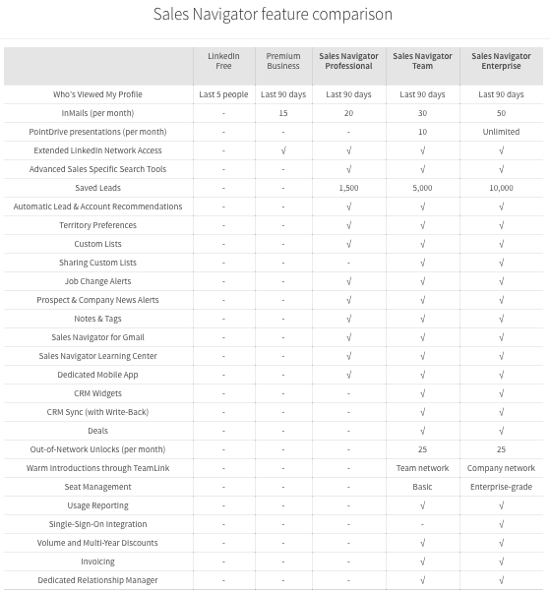
Notice the massive difference in available tools provided between Premium and the Sales Navigator plans. Sales Navigator is specifically designed to help companies bring in leads and boost business, while Premium simply grants you extended network access.
Pros and Cons of LinkedIn Sales Navigator
LinkedIn Sales Navigator is without a doubt an excellent, highly effective tool. It has a range of features that can be beneficial to many companies. But that doesn’t make the tool perfect. It also has shortcomings that can throw obstacles in your workflow and likely frustrate your sales team.
Let’s take a closer look at the pros and cons of Sales Navigator:
Pros
Sales Manager and CRM Integration
Customer relationship management (CRM) systems are incredibly useful tools when it comes to lead generation. LinkedIn allows the integration of a number of different major CRM providers, including HubSpot, Microsoft Dynamics, Salesforce, Zoho, and Infor.
This allows you to have seamless contact management between your CRM and the leads that are generated by Sales Navigator.
Extended Network Access
Sales Navigator allows you to access the network of every person at your company, which greatly expands your pool of connections. Mutual contacts is a great way to get a one-to-one introduction with a prospect, and thus build a much stronger customer relationship.
TeamLink Building
This builds off the previous point, but it’s really cool.
If your business is targeting a specific company as a prospective client, you can head to the TeamLink section of Sales Navigator to see if any of your employees are connected with anyone at that company. This will create a more open pathway for you to reach out and connect with them.
Mobile App
Most business people operate on their phones for half the day, so being able to manage everything from your mobile device is absolutely essential. The Sales Navigator app allows users to save and manage leads, view real time updates, and send InMail to prospects, all from your phone.
Tagging
Sales Navigator has a handy organization tool that allows you to tag your leads to track where they are in the buyer’s journey. You can also leave notes on their profile for yourself or fellow team members with details to keep in mind.
Lead Recommendations
Sales Navigator also includes a nifty little tool that automatically recommends leads to fill up your sales funnel. By editing your sales preferences, you can closely align the automatic recommendations with your target personas.
Cons
Finicky Search
Sales Navigator is known to have a finicky search function – if you can’t quite remember the exact name of that company you want to target, you’re out of luck.
You have to input the exact name, correct spelling, and proper spacing; otherwise you’ll end up with a big old empty bucket of results.
Separate Inboxes
LinkedIn and Sales Navigator don’t necessarily integrate that well with each other, despite basically being the same platform. Your LinkedIn inbox and Sales Navigator are completely separate, so you end up with two inboxes.
This can be incredibly annoying because it could cause your team to miss important messages from prospects.
Internet Issues
Unless you’ve got a decent amount of bandwidth, your team might struggle to use Sales Navigator. It’s a complicated platform and requires a lot of wireless horsepower to run smoothly. Honestly, is there anything more infuriating than slow internet?
Limited InMail Messages
Even with the highest tier plan, you’re still limited to the number of monthly InMail messages you can send. If you’re a big company looking to make a lot of connections, it can be frustrating to have to closely pick and choose who you’re reaching out to.
You have to collaborate with your entire team to make sure that those valuable messages don’t get wasted on dead end prospects.
LinkedIn Sales Navigator Reviews
Sales Navigator has been around for a while now, so it's been tried by a wide range of companies. Overall, the tool has received primarily glowing reviews.
However, users generally have one or two minor complaints about its functionality. We've selected a handful of reviews that exemplify the overall response to Sales Navigator, but for a full list of detailed reviews, check out the G2 Crowd.
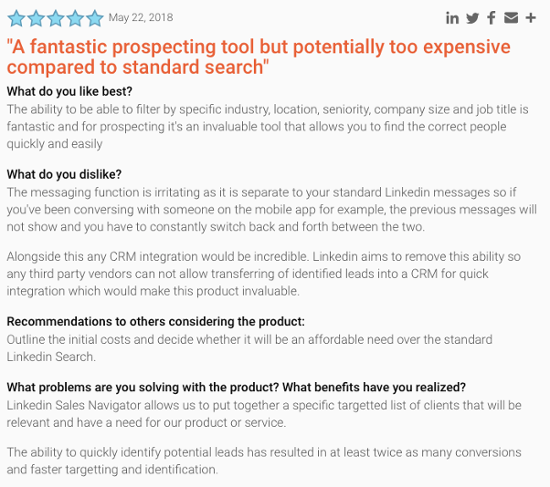 Source: G2 Crowd
Source: G2 Crowd
The Takeaway
Pros
The exceptional search and filtering options are what makes for effective prospecting.
Cons
The separation between LinkedIn and Sales Navigator inboxes is inconvenient and frustrating.
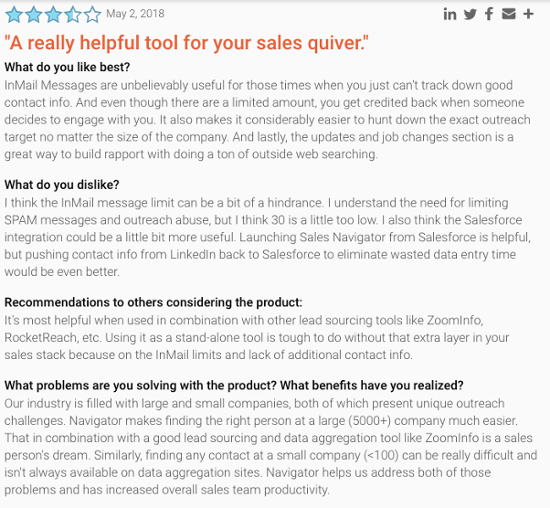 Source: G2 Crowd
Source: G2 Crowd
The Takeaway
Pros
InMail messages are an incredibly useful tool that allows you to target quality leads and build connections.
Cons
The limit of sendable InMail messages is frustrating, and integration of third party CRMs like Salesforce are not completely smooth.
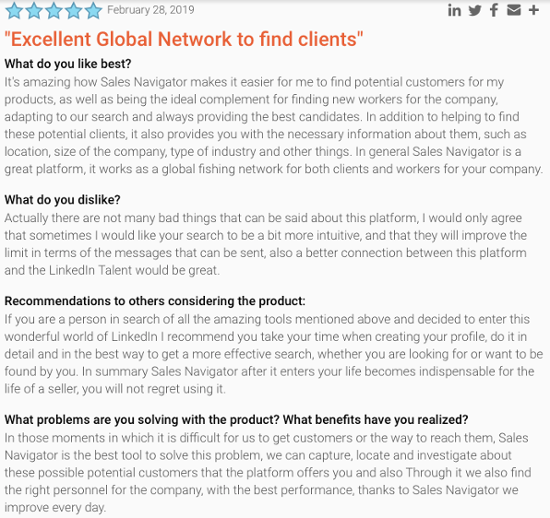 Source: G2 Crowd
Source: G2 Crowd
The Takeaway
Pros
Sales Navigator is great for both prospecting and recruiting, and provides useful information about clients.
Cons
Search could be more intuitive and the overall platform could have better integration with LinkedIn talent manager.
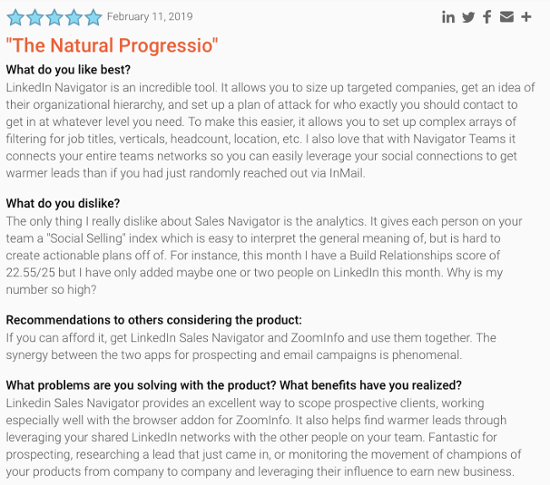 Source: G2 Crowd
Source: G2 Crowd
The Takeaway
Pros
Search filtering creates for targeted results, and team collaboration allows you to utilize social connections to foster stronger relationships with leads.
Cons
Analytics may not be entirely accurate, and it's hard to understand the summary.
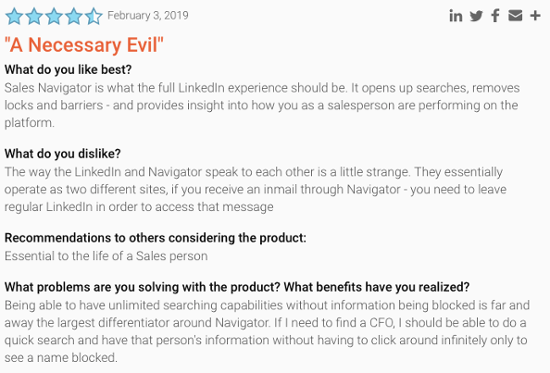 Source: G2 Crowd
Source: G2 Crowd
The Takeaway
Pros
It creates a clear pathway to a better lead generation process, breaking down obstacles and opening doors for your company.
Cons
Once again, LinkedIn and Sales Navigator don't necessarily integrate smoothly with each other.
Consider the Best Option for Your Company
Can you really justify the LinkedIn Sales Navigator cost?
Unfortunately, we can't answer that question for you – it depends entirely on your company. In order to decide whether or not this is a good tool for you, consider the size of your business and how it operates.
How much do you currently engage with your network on LinkedIn? Does your company have an established business profile? Will you make use of all the features provided, or just a few? Will you be able to generate a sufficient budget to cover the costs of this tool?
These are all important questions to ask when considering whether or not Sales Navigator is right for your company.



Claire Cortese
I am a content creator here at Bluleadz. In my free time, I enjoy hugging dogs, watching reruns of The Office, and getting sunburnt at the beach.